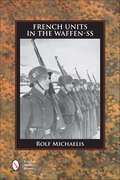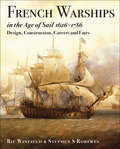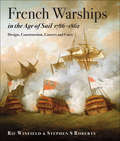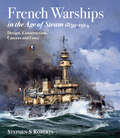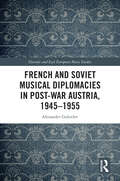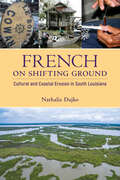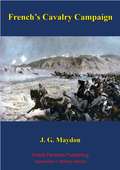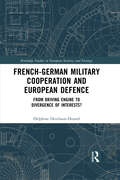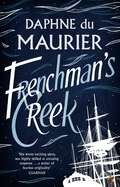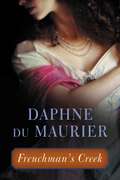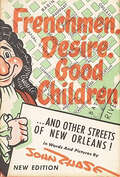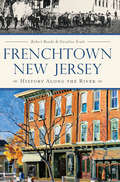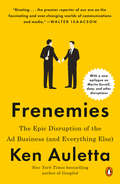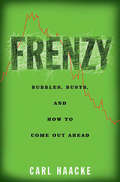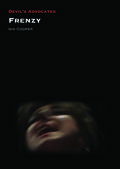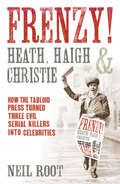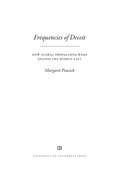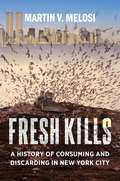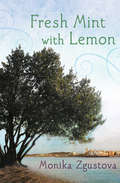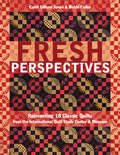- Table View
- List View
French Units in the Waffen-SS
by Rolf MichaelisConcise history of the French Waffen-SS units in WWII
French Urbanism in Foreign Lands
by Ambe J. NjohThis book will seek to close the gaps on the role of France in exporting Eurocentric spatial and environmental design principles and practice. It does so by analyzing the major spatial and physical development projects that French colonial authorities implemented in France's colonial empire and elsewhere from the 15th to the 20th century. French urban planning ideology, principles and practice were not exported exclusively to territories under French colonial suzerainty. Accordingly, the book focuses on major physical and spatial planning schemes inspired by French planning thought in territories without a history of French colonialism.
French Visual Culture and the Making of Medieval Theater
by Laura WeigertThis book revives what was unique, strange and exciting about the variety of performances that took place in the realms of the French kings and Burgundian dukes. Laura Weigert brings together a wealth of visual artifacts and practices to explore this tradition of late medieval performance located not in 'theaters' but in churches, courts, and city streets and squares. By stressing the theatricality rather than the realism of fifteenth-century visual culture and the spectacular rather than the devotional nature of its effects, she offers a new way of thinking about late medieval representation and spectatorship. She shows how images that ostensibly document medieval performance instead revise its characteristic features to conform to a playgoing experience that was associated with classical antiquity. This retrospective vision of the late medieval performance tradition contributed to its demise in sixteenth-century France and promoted assumptions about medieval theater that continue to inform the contemporary disciplines of art and theater history.
French Warship Crews 1789-1805
by Steve Noon Terry CrowdyThis book gives a detailed and authentic account of the life and experiences of French warship crews from the French Revolutionary Wars (1792-1802) up to Trafalgar. It describes the recruitment and composition of crews, the different duties performed and the living conditions they had to endure at sea. Their experiences of fighting the British are covered in depth; from preparing the ship for action, to the violent discharges of heavy calibre guns, the often gruesome realities of sea warfare are revealed through pictures and contemporary testimonies.
French Warships in the Age of Sail, 1626–1786: Design, Construction, Careers And Fates
by Rif WinfieldThe origins of a permanent French sailing navy can be traced to the work of Cardinal Richelieu in the 1620s, but this naval force declined rapidly in the 1650s and a virtually new Marine Royale had to be re-created by Colbert from 1661. Thereafter, Louis XIV"s navy grew rapidly to become the largest and most powerful in the world, at the same time establishing a reputation for the quality of its ship design that lasted until the end of sail. The eighteenth century was to see defeat and decline, revival and victory, but by 1786 the French Navy had emerged from its most successful naval war having frequently outfought or outmanoeuvred the British Navy in battle, and in the process making a major contribution to American independence.This book is the first comprehensive listing of these ships in English, and follows the pattern set by its companion volume on the 1786–1861 period in providing an impressive depth of information. It is organised by Rate, classification and class, with significant technical and building data, followed by highlights of the careers of each ship in every class. Thus for the first time it is possible to form a clear picture of the overall development of French warships throughout the whole of the sailing era.Certain to become the standard English-language reference work, its publication is of the utmost importance to every naval historian and general reader interested in the navies of the sailing era.
French Warships in the Age of Sail, 1786–1861: Design, Construction, Careers and Fates
by Rif Winfield Stephen S RobertsIn 1786 the French Navy had just emerged from its most successful war of the eighteenth century, having frequently outfought or outmanoeuvred the Royal Navy in battle, and made a major contribution to American independence. The reputation of its ship design and fighting skills never stood higher, yet within a few years the effects of the French Revolution had devastated its efficiency, leading to defeat after defeat. Fine ships continued to be built, but even under Napoleon's dynamic influence the navy never recovered sufficiently to alter the balance of sea power. It was only after 1815 that the navy revived, espousing technical innovation and invention, to produce some of the most advanced ships of the age.This book is the first comprehensive listing of these ships in English, and follows the pattern set by the companion series on British warships in the age of sail in providing an impressive depth of information. It is organised by Rate, classification and class, with significant technical and building data, followed by a concise summary of the careers of each ship in every class. Thus for the first time it is possible to form a clear picture of the overall development of French warships in the latter half of the sailing era.
French Warships in the Age of Steam 1859–1914
by Stephen S. RobertsIn 1859 the French navy was at a high point, having fought alongside the British in the Crimean War and developed a formidable fleet of fast wooden-hulled steam ships of the line. But in that very year the world’s navies had to start over again when French naval architect Dupuy de Lôme introduced the ironclad battleship. The French navy then went through three tumultuous phases. In the 1860s and 1870s it focused on building a new traditionally-structured fleet in which wooden-hulled battleships gave way to iron and steel ships with massive guns and armour. In the 1880s and 1890s this effort was disrupted by a vigorous contest between battleship sailors and advocates of fast steel cruisers and small torpedo craft, leaving France by the end of the 1890s with few new battleships (none as large as the best foreign ships) but some two hundred torpedo boats. The Fashoda crisis in 1898 revealed the weakness of the French navy and between 1900 and 1914 the French focused on building a strong battle fleet. In 1914 this fleet remained well behind those of Britain and Germany in numbers, but taken individually French warships remained among the best in the world. This book is the first comprehensive listing in English of the over 1400 warships that were added to the official French navy fleet list between 1 January 1859 and World War I. It includes everything from the largest battleships to a small armoured gunboat that looked like a floating egg. The ships are listed in three separate parts to keep contemporary ships together and then by ship type and class. For each class the book provides a design history explaining why the ships were built, substantial technical characteristics for the ships as completed and after major reconstructions, and selected career milestones including the ultimate fate of each ship. Like its predecessors written jointly with Rif Winfield, French Warships in the Age of Sail 1626-1786 and French Warships in the Age of Sail 1786-1861, with which it forms the third in a trilogy, it provides a complete picture of the overall development of French warships over a period of almost three centuries.
French and American Prisoners of War at Dartmoor Prison, 1805-1816: The Strangest Experiment
by Neil DavieThis book explores the history of Dartmoor War Prison (1805-16). This is not the well-known Victorian convict prison, but a less familiar penal institution, conceived and built nearly half a century earlier in the midst of the long-running wars against France, and destined, not for criminals, but for French and later American prisoners of war. During a period of six and a half years, more than 20,000 captives passed through its gates. Drawing on contemporary official records from Britain, France and the USA, and a wealth of prisoners’ letters, diaries and memoirs (many of them studied here in detail for the first time), this book examines how Dartmoor War Prison was conceived and designed; how it was administered both from London and on the ground; how the fate of its prisoners intertwined with the military and diplomatic history of the period; and finally how those prisoners interacted with each other, with their captors, and with the wider community. The history of the prison on the moor is one marked by high hopes and noble intentions, but also of neglect, hardship, disease and death
French and Soviet Musical Diplomacies in Post-War Austria, 1945-1955 (Slavonic and East European Music Studies)
by Alexander GolovlevFrench and Soviet Musical Diplomacies in Post-War Austria, 1945-1955 investigates how promoting 'national' music and musicians was used as an important asset by France and the USSR in post-Nazi Austria, covering music’s role in international relations at various levels, within changing power frameworks. Bridging international relations, musical sociology, media studies, and Cold War history, four incisive chapters examine the crossroads of Soviet, French, and Austrian cultural politics and discourse-building, presented in two parts - institutions of musical diplomacy: Soviet and French cultural diplomats in comparison; sounds of music coming to Austria: Soviet and French musicians on tour. Using a communication- and media-oriented approach, this study casts new light, firstly, on the interpretative power of 'receiving' publics and, secondly, on the role of cultural transmitters at different levels. This is a valuable study for those specialising in Russian and East European music and music and politics. It will also appeal to cultural historians and all those interested in the intersections between music, international relations, and Cold War history.
French on Shifting Ground: Cultural and Coastal Erosion in South Louisiana (America's Third Coast Series)
by Nathalie DajkoIn French on Shifting Ground: Cultural and Coastal Erosion in South Louisiana, Nathalie Dajko introduces readers to the lower Lafourche Basin, Louisiana, where the land, a language, and a way of life are at risk due to climate change, environmental disaster, and coastal erosion. Louisiana French is endangered all around the state, but in the lower Lafourche Basin the shift to English is accompanied by the equally rapid disappearance of the land on which its speakers live. French on Shifting Ground allows both scholars and the general public to get an overview of how rich and diverse the French language in Louisiana is, and serves as a key reminder that Louisiana serves as a prime repository for Native and heritage languages, ranking among the strongest preservation regions in the southern and eastern US. Nathalie Dajko outlines the development of French in the region, highlighting the features that make it unique in the world and including the first published comparison of the way it is spoken by the local American Indian and Cajun populations. She then weaves together evidence from multiple lines of linguistic research, years of extensive participant observation, and personal narratives from the residents themselves to illustrate the ways in which language—in this case French—is as fundamental to the creation of place as is the physical landscape. It is a story at once scholarly and personal: the loss of the land and the concomitant loss of the language have implications for the academic community as well as for the people whose cultures—and identities—are literally at stake.
French's Cavalry Campaign
by John George MaydonField-Marshal French is best known for his military services during the First World War; however, his military service stretches back through to his commands in the Boer War. In his campaigns with the newly formed cavalry division he was to receive much acclaim and praise for his adroit handling of his troops and their effectiveness against the largely irregular Boers. He won the battle of Elanslaagte and, having escaped the encirclement of Ladysmith, led his troops on to the capture of Bloemfontain and the relief of Kimberley. Tough and uncompromising, he became a celebrity with the papers back home, his character summed up by the verse:"E's so tough and terse 'E don't want no bloomin' nurse and 'E ain't had one reverse Ave yer, French?"This book charts Colonel French's adventurous division across the vledts and kops of the South African landscape with pace and verve.The author, John George Maydon, was a prominent member of the Natal parliament that accompanied Colonel French on his cavalry campaign and writes from this unique perspective combining local South African knowledge with a loyalist viewpoint.
French-German Military Cooperation and European Defence: From Driving Engine to Divergence of Interests? (Routledge Studies in European Security and Strategy)
by Delphine Deschaux-DutardThis book examines the role of French-German cooperation within European military cooperation and European defence, and particularly the CSDP (Common Security and Defence Policy).The work explores whether Franco-German bilateral leadership is still relevant in European defence and military cooperation at the EU level, and analyses the reasons for its difficulties in the current context of the return to conventional warfare on the European continent. With an innovative research design that mixes a conceptual framework (discursive institutionalism) with tools from the sociology of International Relations, the book offers both a macro- and an actor-level perspective. The focus on the strategic discourses of both French and German actors, and the institutional settings within which these discourses develop, also enables to better grasp the complexity of military cooperation and the recurring limits of bilateral leadership by Paris and Berlin. Based on extensive fieldwork in Paris, Berlin and Brussels over the past two decades, including data collected since 2022, the book offers a longitudinal view of the issue as well as the most recent developments since the outbreak of the war in Ukraine.This book will be of much interest to students of European security, European politics and security studies in general.
Frenchman's Creek (Virago Modern Classics #112)
by Daphne Du MaurierA tale of love and adventure from the internationally bestselling author of RebeccaThe Restoration Court knows Lady Dona St Columb to be ripe for any folly, any outrage that will alter the tedium of her days. But there is another, secret Dona who longs for freedom, honest love - and sweetness, even if it is spiced with danger. To escape the shallowness of court life, Dona retreats to Navron, her husband's remote Cornish estate. There, she seeks peace in its solitary woods and hidden creeks. But she finds instead a daring pirate, hunted by all Cornwall, a Frenchman who, like Dona, would gamble his life for a moment's joy. Together, they embark upon a quest rife with danger and glory, one which bestows upon Dona the ultimate choice: sacrifice her lover to certain death or risk her own life to save him.One of the last century's most original literary talents - Daily Telegraph
Frenchman's Creek (Virago Modern Classics #112)
by Daphne Du MaurierA tale of love and adventure from the internationally bestselling author of RebeccaThe Restoration Court knows Lady Dona St Columb to be ripe for any folly, any outrage that will alter the tedium of her days. But there is another, secret Dona who longs for freedom, honest love - and sweetness, even if it is spiced with danger. To escape the shallowness of court life, Dona retreats to Navron, her husband's remote Cornish estate. There, she seeks peace in its solitary woods and hidden creeks. But she finds instead a daring pirate, hunted by all Cornwall, a Frenchman who, like Dona, would gamble his life for a moment's joy. Together, they embark upon a quest rife with danger and glory, one which bestows upon Dona the ultimate choice: sacrifice her lover to certain death or risk her own life to save him.One of the last century's most original literary talents - Daily Telegraph
Frenchman's Creek (Virago Modern Classics #2160)
by Daphne Du MaurierLady Dona is bored with stylish life at Court so she sets off for freedom to her husband's Cornwall estate. She comes across the white-sailed ship belonging to a Frenchman who robs the shores of Cornwall. This pirate steals the heart of the Lady.
Frenchmen, Desire, Good Children: . . . and Other Streets of New Orleans!
by John Chase"John Chase has taken what in lesser hands would have been a dull recounting of fact and made a delightfully accurate yet breezy book." -New Orleans Times-Picayune"History in its most painless form . . . lightened not only by cartoons but by narrative approach."-New York Herald TribuneThe history of New Orleans is a street-level story, with names like Iberville, Terpsichore, Gravier, Tchoupitoulas, and, of course, Bourbon, presenting the city's past with every step. The late John Churchill Chase eloquently chronicles the origins and development of the most fascinating of American cities in this humorous read.Frenchmen, Desire, Good Children details the interesting stories of the developers and families as well as the infamous and famous people, places, and events from which the city's names and character are drawn. First published by now-defunct New Orleans publisher Robert L. Crager in 1949, the book remains funny and informative, generally accepted as a standard reference about the Crescent City.
Frenchtown, New Jersey: History Along the River (Brief History)
by Caroline Scutt Robert RandoFrenchtown is a picturesque community on the banks of the Delaware River. In the late 1700s, a series of land sales to French-speaking Swiss gave the town its name. The river fostered the town's growth throughout the nineteenth century, bringing railroads and successful businesses like Frenchtown Porcelain Works. Remnants of this industrial past are still visible in places like the Delaware and Raritan Canal State Park. Visitors and locals admire historic landmarks along Bridge Street, including the Frenchtown Inn and the Hummer Building. Annual celebrations like Bastille Day and RiverFest celebrate the town's home and heritage. Local authors Robert Rando and Caroline Scutt commemorate the unique history of this bucolic New Jersey community.
Frenemies: The Epic Disruption of the Ad Business (and Everything Else)
by Ken AulettaAn intimate and profound reckoning with the changes buffeting the $2 trillion global advertising and marketing business from the perspective of its most powerful players, by the bestselling author of GoogledAdvertising and marketing touches on every corner of our lives, and is the invisible fuel powering almost all media. Complain about it though we might, without it the world would be a darker place. And of all the industries wracked by change in the digital age, few have been turned on its head as dramatically as this one has. We are a long way from the days of Don Draper; as Mad Men is turned into Math Men (and women--though too few), as an instinctual art is transformed into a science, the old lions and their kingdoms are feeling real fear, however bravely they might roar. Frenemies is Ken Auletta's reckoning with an industry under existential assault. He enters the rooms of the ad world's most important players, some of them business partners, some adversaries, many "frenemies," a term whose ubiquitous use in this industry reveals the level of anxiety, as former allies become competitors, and accusations of kickbacks and corruption swirl. We meet the old guard, including Sir Martin Sorrell, the legendary head of WPP, the world's largest ad agency holding company; while others play nice with Facebook and Google, he rants, some say Lear-like, out on the heath. There is Irwin Gotlieb, maestro of the media agency GroupM, the most powerful media agency, but like all media agencies it is staring into the headlights as ad buying is more and more done by machine in the age of Oracle and IBM. We see the world from the vantage of its new powers, like Carolyn Everson, Facebook's head of Sales, and other brash and scrappy creatives who are driving change, as millennials and others who disdain ads as an interruption employ technology to zap them. We also peer into the future, looking at what is replacing traditional advertising. And throughout we follow the industry's peerless matchmaker, Michael Kassan, whose company, MediaLink, connects all these players together, serving as the industry's foremost power broker, a position which feasts on times of fear and change. Frenemies is essential reading, not simply because of what it says about this world, but because of the potential consequences: the survival of media as we know it depends on the money generated by advertising and marketing--revenue that is in peril in the face of technological changes and the fraying trust between the industry's key players.
Frenzy
by Carl HaackeDespite the hype, the technology bubble of the 1990s was not driven by the Internet. It was driven by innate human forces that transcend the Internet, the 1990s the 20th century, and the United States. Since the 1960s, there has rarely been a year with out a bubble somewhere. Today we see bubbles in China, nano-technology, real estate, and many more are on the way.Through an in-depth analysis and interviews with over 100 of the world's most influential venture capitalists, Fortune 500 CEOs and Wall Street's multi-billion dollar portfolio managers, Frenzy reveals the unexpected driving forces of bubbles. Frenzy provides critical insights and lessons for today's business professionals, investors and policy makers to manage the bubbles of the future.
Frenzy (Devil's Advocates)
by Ian Cooper?Frenzy (1972) was Alfred Hitchcock's penultimate film, and arguably one of his most misunderstood and neglected. Whereas even Psycho (1960) did eventually become respectable – indeed, it's a good contender for the most admired of the Master's films - Frenzy still remains problematic for many. While Raymond De Foery makes his feelings clear in the title of his book, Alfred Hitchcock's Frenzy: The Last Masterpiece, Hitchcock's controversial biographer Donald Spoto calls the film "repulsive" and "a closed and coldly negative vision of human possibility". Frenzy is perhaps Hitchcock's most nakedly autobiographical film and one which represented both a comeback and farewell to the city of his birth. But it started out as a very different kind of project. This Devil's Advocate discusses the evolution of the film, its production, reception, and place in Hitchcock's oeuvre, as well as its status as, the author argues, a key film of 'sleazy Seventies' British cinema.
Frenzy!: How the tabloid press turned three evil serial killers into celebrities
by Neil RootMurder has transfixed the popular press for centuries. But it was only in the second half of the twentieth century that murder began saturating front pages and making these monsters what we today recognise as modern celebrities. It was three serial killers, caught and executed in the few years after the end of the Second World War, who precipitated a level of public furore never seen before. Neville Heath, a 'charming' sadist who killed two women; John George Haigh, the Acid Bath Killer who killed between six and nine men and women; and John Christie, the ineffectual necrophile, who killed between six and eight women. The modern news coverage finds its roots with these three men whom the crime historian Donald Thomas called the 'Postwar Psychopaths'. Their crimes were the first to generate a tabloid frenzy the like of which we see all around us today. It was not only the murderers who captured the public's imagination. It was the detectives who hunted them down, the judiciary who tried them, and the man who executed them, the legendary hangman Albert Pierrepoint.This book tells the stories of these three infamous serial killers against the backdrop of the tabloid frenzy that surrounded them.
Frequencies of Deceit: How Global Propaganda Wars Shaped the Middle East
by Margaret Elizabeth PeacockOn June 8, 1967, Egypt's most famous radio broadcaster, Ahmed Said, reported that Egyptian, Syrian, and Jordanian forces had defeated the Israeli army in the Sinai, had hobbled their British and US allies, and were liberating Palestine. It was a lie. For the rest of his life, populations in the Middle East vilified Said for his duplicity. However, the truth was that, by 1967, all the world's major broadcasters to the Middle East were dissimulating on the air. For two decades, British, Soviet, American, and Egyptian radio voices created an audio world characterized by deceit and betrayal. In this important and timely book, Margaret Peacock traces the history of deception and propaganda in Middle Eastern international radio. Peacock makes the compelling argument that this betrayal contributed to the loss of faith in Western and secular state-led political solutions for many in the Arab world, laying the groundwork for the rise of political Islam.
Fresh Kills: A History of Consuming and Discarding in New York City
by Martin V. MelosiFresh Kills—a monumental 2,200-acre site on Staten Island—was once the world’s largest landfill. From 1948 to 2001, it was the main receptacle for New York City’s refuse. After the 9/11 attacks, it reopened briefly to receive human remains and rubble from the destroyed Twin Towers, turning a notorious disposal site into a cemetery. Today, a mammoth reclamation project is transforming the landfill site, constructing an expansive park three times the size of Central Park.Martin V. Melosi provides a comprehensive chronicle of Fresh Kills that offers new insights into the growth and development of New York City and the relationship among consumption, waste, and disposal. He traces the metamorphoses of the landscape, following it from salt marsh to landfill to cemetery and looks ahead to the future park. By centering the problem of solid-waste disposal, Melosi highlights the unwanted consequences of mass consumption. He presents the Fresh Kills space as an embodiment of massive waste, linking consumption to the continuing presence of its discards. Melosi also uses the landfill as a lens for understanding Staten Island’s history and its relationship with greater New York City. The first book on the history of the iconic landfill, Fresh Kills unites environmental, political, and cultural history to offer a reflection on material culture, consumer practices, and perceptions of value and worthlessness.
Fresh Mint with Lemon
by Monika ZgustovaDuring a sultry month on the Mediterranean coast, tension mounts in a triangle of love, power, and desire between a Russian art critic, an American artist, and a provocative activistRussian art critic Vadim meets a mysterious North American artist of Russian origins, Patricia Pavloff, in Saint Petersburg. Captivated by the painter&’s brilliance, the young critic travels to the coastal Catalonian town of Sitges, where Patricia lives, hoping to interview her and write a book about her work. Vadim&’s dreams of being admitted to the inner sanctuary of the artist&’s studio wax and wane as Patricia&’s personality oscillates between two extremes. She&’s friendly and playful one moment, cold and distant the next. Patricia shares her house with the voluptuous and provocative Radhika, whose power games foster an unsettling dynamic between the three. Attracted by Radhika&’s beauty but repelled by her politics, Vadim doesn&’t know which of the two women he desires most. Underlying the sexual and romantic tension are the dramatic events of the Prague Spring of 1968, cut short by the Soviet invasion. The juxtaposition of two narratives provokes fresh perspectives in this multi-layered and sensual exploration of the nature of love, art, guilt, and freedom.
Fresh Perspectives: Reinventing 18 Classic Quilts from the International Quilt Study Center & Museum
by Carol Gilham Jones Bobbi Finley“Carol and Bobbi have done a stunning job of transforming the designs . . . a valuable source of information and inspiration for all quilt lovers.” —Machine Quilting UnlimitedYou’ll love these contemporary interpretations of antique quilts from the International Quilt Study Center. Bobbi Finley and Carol Gillham Jones pored through the museum’s collection to find inspiration quilts for their latest project designs, ranging from simply functional to delightfully pictorial. These projects show off a remarkable array of styles, settings, and colorways—each adaptation uniquely mirrors the essential qualities of each quilt. Celebrate our rich quilt heritage by making these projects using various techniques like appliqué or improvisational piecing with traditional blocks. Plus you’ll learn how to approach designing an artistic spin on your own antique treasures.“As the saying goes, what goes around comes around and we are still drawing inspiration from quilters whether their work is classed as antique or innovative.” —Fabrications Quilting for You
